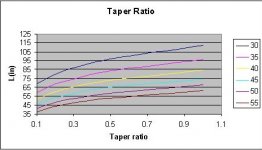A transmission line speaker has to be stuffed to limit the ripples induced by the line. What if a speaker with a double (twin) TL could be made in a MTM arrangement with two different line length, so that the dips of one corresponds to the peaks of the other, and both produce a much smoother response without (or with minimal) stuffing ? Maybe the Ariel speaker is designed with this feature as the two drivers see a different line in the speaker ? Sorry if this question seem stupid or has been yet answered (I see no topic on that...)
Interesting idea, I think other ways of doing this have been tried (a second driver, or changing the position of the driver), but not much work has been done on this. Martin King's papers discuss the position of the driver.
From the reading I've done, a TL is best used up to the first peak, then crossed over to mid drivers. So the thing to do is ensure that peak is no lower than you want, but that has to be consistent with the LF response desired...???
From the reading I've done, a TL is best used up to the first peak, then crossed over to mid drivers. So the thing to do is ensure that peak is no lower than you want, but that has to be consistent with the LF response desired...???
AFAIK, the Ariel's line-length is the same.
Thing is though, it's going to depend on what's called a TL. A TL in the strict sense of the word is a ~non-resonant, damped system by nature, so you can't actually have one without the stuffing. A purist TL is essentially concerned with the flattest possible impedance -the ~ 'perfect load' for an amplifier.
Regarding resonant / semi-resonant lines, which tend to get lumped in with the TL moniker, even though they're not really the same thing in terms of objective, yes, it's certainly feasible to use differential tuning, one, say, 1/2 octave about the other to smooth things out, but IMO, it's making life harder than it really needs to be. You can make an lightly damped MLTL (or ML QWR) with a ruler flat response easily enough.
Thing is though, it's going to depend on what's called a TL. A TL in the strict sense of the word is a ~non-resonant, damped system by nature, so you can't actually have one without the stuffing. A purist TL is essentially concerned with the flattest possible impedance -the ~ 'perfect load' for an amplifier.
Regarding resonant / semi-resonant lines, which tend to get lumped in with the TL moniker, even though they're not really the same thing in terms of objective, yes, it's certainly feasible to use differential tuning, one, say, 1/2 octave about the other to smooth things out, but IMO, it's making life harder than it really needs to be. You can make an lightly damped MLTL (or ML QWR) with a ruler flat response easily enough.
Well, the transition from BR to MLTL is easy enough.  The point at which the standing waves generated by the enclosure affect the behaviour you would expect from a purely helmholtz action marks the transition from one loading to the other.
The point at which the standing waves generated by the enclosure affect the behaviour you would expect from a purely helmholtz action marks the transition from one loading to the other.
The others are more open points of course. It's interesting re the tapering actually, because a negative taper itself can be defined as mass-loading. And then...
The others are more open points of course. It's interesting re the tapering actually, because a negative taper itself can be defined as mass-loading. And then...

Scott, Pete, thanks for your replies. I see I have to study M.J. King models more attentively before going on with this "twin complementary" (ML)TL intuition. The idea remains to avoid offsetting drivers and stuffing the lines, for maximum line loading while keeping response ripple-free. Starting point is : same drivers, same volume in the lines but different lengths and taper ratios.
Well, it's just an intuition, as borderline and "non-purist" as an intuition from a newbie can be. Still, I have to learn more about this... Thanks for help in finding data, models and experience.
Well, it's just an intuition, as borderline and "non-purist" as an intuition from a newbie can be. Still, I have to learn more about this... Thanks for help in finding data, models and experience.
- Status
- This old topic is closed. If you want to reopen this topic, contact a moderator using the "Report Post" button.
- Home
- Loudspeakers
- Multi-Way
- twin TL speaker
